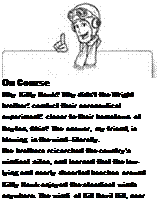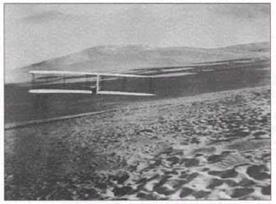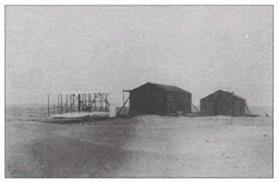Getting Off the Ground
The Wright brothers’ first flight at Kill Devil Hill in December 1903 was as much an exercise in audacity as it was a test of flying know-how. The brothers, who ran their own bicycle shop and who had taught themselves how to build everything from printing presses to airplane propellers, braved something that more timid souls at the time thought was suicidal folly: They strapped themselves to a craft that was little more than an oversized kite and lit the fires of a temperamental motor that spun a pair of homemade wooden propellers. If nothing else, Wilbur and Orville Wright were brave!
But the Wrights were also brilliant. They were voracious gatherers of new information and fresh news about the technology of flight. They stayed in touch with the most advanced experimenters and incorporated the best results of competitors’ work into their own, then added a dash of their own genius to the mix.
And they were unparalleled tinkerers. Together, there was almost no machine they needed that they couldn’t fashion out of spare parts and rubbish they found lying around their shop. Once, in 1892, the brothers used a broken tombstone and some spare buggy parts to cobble together a printing press that they used to start a printing business and to print their own newspaper.
|
Before they put a motor and two propellers on their airplane, the Wrights spent years refining their piloting instincts by flying gliders off any hillside they could find. |
In 1896, while Wilbur was housebound recovering from an injury, the brothers read about the tragic death of glider pioneer Otto Lilienthal. (Read more about Lilienthal in Chapter 1, “The Earliest Aviators.”) Right away, they began devouring every book they could find about Lilienthal, his gliders, and the newly born science of aeronautics. It wasn’t long before the brothers concluded that much of Lilienthal’s findings were wrong and they began conducting flight tests using gliders of their own design.
|
Life wasn’t very sweet on the cold, windswept dunes of Kill Devil Hill, North Carolina. The Wright brothers and the few locals who helped them work on their airplane often had to duck into a shack for shelter from the piercing wind that seemed to blow continuously. |
 |
 |
While they were testing Lilienthal’s research, the Wright brothers happened upon a 30-year-old technology called the “wind tunnel,” which helped them put theoretical aerodynamics to the test. Their wind tunnel was the first ever built in the modern style, using a large mouth to draw air in, then accelerating it through a narrow throat. Even without their later successes in controlled powered flight, their wind-tunnel innovation alone would have placed the Wrights firmly among the pantheon of aviation pathfinders.













